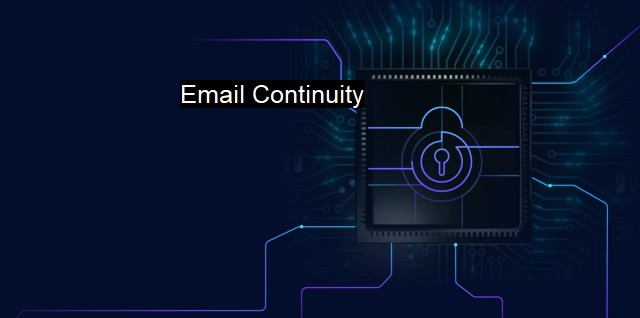What is Email Continuity?
Ensuring Uninterrupted Business Communication: The Significance of Email Continuity in Cybersecurity and Data Protection
Email continuity is a concept in cybersecurity that ensures consistent and uninterrupted access to email communication while maintaining the integrity, confidentiality, and reliability of the emails, regardless of any technical difficulties the email system might face. It involves maintaining the accessibility and usability of email even in adverse situations like system failure, hacking, or infrastructure disruption. How, you might ask? For that, one must delve deeper into the underlying concepts of email continuity to understand how it helps in maintaining steady email contact.The necessity for email continuity largely stems from the importance of electronic communication in modern business activities. Email has transformed into the principal means of interaction for organizations. Significant information, agreements, notifications, instructions, and impactful business decisions are often transferred through emails in this digital age. Hence, even a minor disruption in accessing this channel can lead to severe consequences for the functioning of a business.
This highlights the vital place of email continuity and forms the basis for its integration into cybersecurity. Today, cyber-genic disasters are as consequential, or perhaps more so in certain scenarios, as traditional calamities. For instance, a ransomware attack that targets the email server of a company can potentially disrupt an organization's entire communication network. By leveraging email continuity as part of an overall cybersecurity strategy, organizations can mitigate such risks.
Email continuity often utilizes a cloud-based system that keeps running despite any issues with the centralized server. Therefore, it involves replicating the email system onto a sturdy platform. By doing so, even if the primary server faces any disruptions due to threats like DDoS attacks or hardware failure, users can still access and operate their emails seamlessly.
An ideal email continuity strategy would also defend in-transit and stored emails from malware and antivirus threats. Advanced hyper-scale cloud platforms, which possess built-in threat intelligence and machine learning algorithms, can automatically filter out suspicious mails, thwart potential phishing attempts, and control harmful downloads by analyzing their metadata patterns, even while attaining secure access to emails during server downtimes.
Additional tools part of the email continuity construct enhance security as well. Features like encrypted email communication to flush out intrusive cyber threats, time-bound message recall to prevent unwanted accessibility and further incorporation of inbound filtering to reduce spam, viruses, and other malware interventions, are instrumental in ensuring the emails' security and integrity.
There's also the need for quick and seamless transition time for on-premise or hosted email systems to the email continuity mode when unpredictable disruptions occur. This is effectively achieved with the automation of transitioning following predefined thresholds and alerts.
Auto updates further facilitate email continuity, thereby securing the system in case of new virus strains. And on spotting any such intrusion attempt affecting the uptime, these cybersecurity strategies might even quarantine the corresponding emails, thus, minimizing the risk exposure.
There's also a compliance aspect intersecting email continuity and cybersecurity. Organizations in specific industries, for instance, health, finance, etc., ought to comply with respective legislation and rules regarding data & information management, which in turn influences the strategy for email continuity, considering its containment of sensitive information.
It's crucial to regularly test, audit, and update the plans, especially after major system or infrastructure changes. Such measures can spot potential weaknesses or failings ahead of time, fortifying the email continuity set-up against would-be attackers.
All in all, the cybersecurity touchstones within the ampleness of email continuity ensures uninterrupted access to email systems, safeguards against potential cyber threats, guaranteeing protection from data breaches and loss, improvising on the communication capabilities, and regulatory compliance. Its necessity isn't in doubt – how well it's implemented will make all the difference in the fast-paced, high-stakes, digital world we operate in.

Email Continuity FAQs
What is email continuity?
Email continuity is the ability to maintain access to email systems and data in the event of an unexpected disruption, such as a cyber-attack or network outage. It ensures that businesses can continue to operate and communicate even in the face of such disruptions.Why is email continuity important for cybersecurity?
Email continuity is important for cybersecurity as it ensures that businesses can continue to communicate and access critical data even in the event of a cyberattack or other security incident. It prevents disruptions to business operations and minimizes the impact of cybersecurity threats.How does email continuity help protect against viruses?
Email continuity can help protect against viruses by ensuring that businesses have access to their email systems and data even in the event of a virus or malware attack. This allows them to quickly identify and address any threats, minimizing the potential damage and preventing the spread of viruses to other systems.What features should I look for in an email continuity solution?
When choosing an email continuity solution, you should look for features such as automatic failover to backup systems, real-time email monitoring and alerts, email archiving and search capabilities, and robust security measures such as encryption and multi-factor authentication. These features will ensure that your business is protected against potential email disruptions and cyber threats.| | A | | | B | | | C | | | D | | | E | | | F | | | G | | | H | | | I | | | J | | | K | | | L | | | M | |
| | N | | | O | | | P | | | Q | | | R | | | S | | | T | | | U | | | V | | | W | | | X | | | Y | | | Z | |
| | 1 | | | 2 | | | 3 | | | 4 | | | 7 | | | 8 | | |||||||